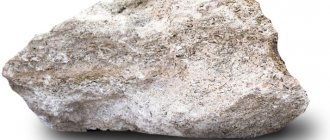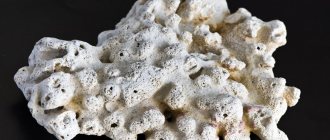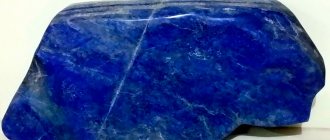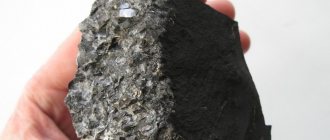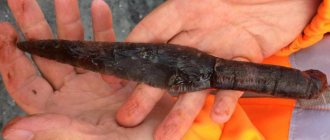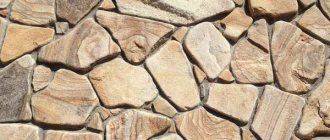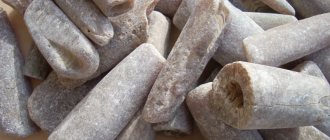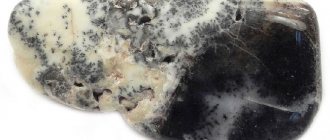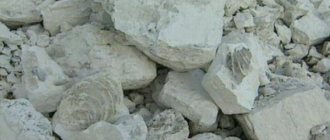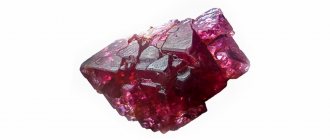Limestone is a rock formed by the deposition of carbonate material and subsequent modification by factors promoting cementation and recrystallization. The excellent technical parameters of the rock allow it to be used in many areas of production, construction, and metallurgy.
Limestone is a rock formed by the deposition of carbonate material and subsequent modification by factors promoting cementation and recrystallization
Conditions for the formation of carbonate deposits
Limestone is a mineral formation formed as a result of the deposition of skeletal remains of biological organisms and consisting primarily of calcite and partly aragonite. The chemical composition of limestone is close to calcite.
Carbonate material of various origins is common in sedimentary rocks. Similar to the quartz component, the sediments contain fragments of limestone, which is a product of the destruction of existing sediments.
Typical deposited limestone material is found in basal and carbonate conglomerates. Much more common are calcareous sandstones and breccias, consisting of fragments of material that have not been processed as a result of being transported over a distance by wind and water.
This fact allows us to assume their formation in shallow water conditions, in which a number of sections of the seabed rose above the water level and were destroyed as a result of abrasive processes.
It can be assumed that shell limestone was formed under such conditions. It is this type of sedimentary rock that is represented by the entire remains of organisms and their fragments.
We also recommend reading:
The history and curse of the Kohinoor stone The marvelous ametrine stone Characteristics of larimar and its main properties Selection of stones by date of birth
Many organogenic-clastic limestone rocks are represented by the products of sorting of not yet fossilized remains of shallow-water sediments. This type of accumulation forms a group of organogenic formations.
If bioherms (corals that form calcareous formations) immediately form hardened sediments, then the hardening of calcareous sediments is associated with additional chemical transformations of the carbonate part of the sediments.
Sometimes limestones are distinguished by a special spongy structure formed due to dolomitization. Such reef rocks contain oil.
Table
Now we can give a clear answer to the question of what is the difference between lime and chalk. The table below summarizes what these materials have in common and how they differ.
| Lime | Chalk | |
| What is | A group of chemical compounds and mixtures containing calcium. Comprises:
| Sedimentary rock formed from the remains of ancient simple organisms |
| Application area |
| Production of coated paper, as student chalk at school, as a cheap filler in the production of polymers and varnishes, as well as in the food industry and for whitewashing trees, borders, etc. |
Types of formations
Chemogenic formations (rocks formed without the participation of biological processes) are divided into types depending on the structure of the rock and the grain size of the carbonate clastic material and determine the nature of the rock formation and the origin of the limestone.
Micrograined rock is the result of the vital activity of microorganisms and is a product of their processing of calcium nitrate into a carbonate compound.
White limestone, which is a mass of micro-grained carbonate material, is not usually composed entirely of chemogenic sediment. As a detailed study of writing chalk under a microscope shows, the microgranular part of the calcium carbonate compound (limestone formula CaCO3) contains the remains of the skeletons of microscopic coccolithophorid organisms.
The second type of formations is represented by calcareous crusts and characteristic inlays. The sediments formed directly on the bottom of the sedimentary basin, evenly distributed over the fossilized sediment.
White limestone, which is a mass of micro-grained carbonate material, is not usually composed entirely of chemogenic sediment
Favorable formation conditions at the bottom of shallow areas could be suitable for the direct release of calcium carbonate and characterized by an increased temperature gradient.
Among the hemogenic formations other than coral reefs are concentric oolites, which form a special type of sediment. The cores of the formations contain carbonate or other sandstones and foraminifera.
The recrystallization of sediment that occurs in reef limestones is associated with coarsening mineral encrustations under conditions of additional sedimentation in the upper parts of the silt.
The process can be facilitated by shallowing conditions if they lead to an increase in water temperature and an upward change in the level of the neutral environment. The degree of crystallization distinguishes or brings together successively changing layers of limestone sediments.
Complete recrystallization of sediments with the destruction of the cemented material completely erases the difference between fragmentary material and cement. An example of this type of deposit is marbled limestone.
The uneven development of crystallization processes in the rock determines the coarse-grained structure of sediments.
Characteristics and origin of calcareous mineral
Natural stone limestone is a non-solid sedimentary rock with a maximum content of calcite. The rest of the mineral mass consists of inclusions of particles of other substances (silicon, phosphates, quartz, lime, etc.). Microparticles of the skeletons of simple organisms can also be found in the mass of calcium carbonate. The origin is generally characterized as organic, but there is also an organo-chemical path to the formation of the mineral.
The limestone mineral is mainly formed in the shallow water environment of the sea basin. .jpg” alt=”natural limestone” width=”300″ height=”225″> Freshwater conditions also allow limestone to be deposited. Its usual form of occurrence is a layer. It can be deposited according to the principle of salt: during the evaporation of water from lakes and lagoons. But the bulk of the stone originated precisely in the depths of the sea, where there were no intense processes of evaporation and drying.
The natural mechanism of mineral formation begins with the work of living organisms. They extract calcite from seawater and build shells. Then the remains of their skeletons accumulate on the bottom surface in a huge mass. The most significant example of the formation of calcite carbonate is the birth, growth and death of coral reefs. It is not uncommon for piece shells to be found on a fracture in a calcareous rock. This variety is called shell rock.
Other species are also named according to the types of organisms and their metabolic products:
- nummulitic;
- bryozoan;
- oolitic.
Marble-like limestone is a separate category. It, in turn, is divided into massively layered and thin-layered types. Under the influence of certain temperatures and pressure, it changes the structure of the crystals and is transformed into marble.
Technical Parameters of Limestone
Dolomites and limestones containing magnesium carbonate have greater hardness. They are more difficult to mechanically influence.
Natural limestone is durable and hard. When crushed, it forms an uneven fracture. Doesn't get wet in water. The physical properties of the rock allow it to be used in construction.
Usually the carbonate compound is white, gray in color. But depending on the presence of impurities, the external color and technical characteristics of limestone change. The minerals contained in the formation not only change color, but also affect strength, stability and determine the scope of application.
The carbonaceous substance colors the rock black, the yellow color is determined by the presence of iron hydroxides, and the greenish color is determined by glauconite.
A description of the technical parameters of the material is contained in the deposit passport. The information collected in the document fully reflects the properties of the breed and its compliance with state standards regulated by law.
The structure of limestone allows us to distinguish types of rock. The texture of the mineral formation is uniform, sometimes there are pores and cavities (voids).
Extraction methods
There are 2 methods of limestone extraction:
- traditional method;
- explosive method.
The first method is as simple as possible. Using special equipment, the entire top layer of soil, under which there is valuable rock, is removed. Next, the stone is extracted. Special equipment is used for extraction. Since each deposit has a limited supply of stone, after complete clearing of the quarry it is necessary to carry out reclamation. Special equipment is also used for this.
The second method is used in conjunction with the first. If the deposit is very large, the explosion method is used to speed up production. The quarry is filled with explosives, which make it possible to crush the stone, as well as break off a layer from the general deposits of stone. After this, all that remains is to collect small and large fragments. It is worth noting that instead of explosives, another loosening method can be used - hydraulic. It is less dangerous, but not as effective and fast as explosive.
What are formations characterized by?
Among carbonate deposits, the following types of limestone are distinguished:
- dense carbonates (characterized by a homogeneous structure);
- oolitic formations of spherical shape;
- tuffs are formations with large pores, which are durable and easy to process (polished, grinded);
- travertine – sinter formations;
- clayey and bituminous limestones.
The coral limestone in the sediments is supplemented with an admixture of foraminiferal shells and mollusks, and echinoderm shells. The rock that makes up modern reefs has a hard, porous structure and consists of the skeletons of colonies of polyps.
Putilov limestone is known as the main building material used during the construction of the city of St. Petersburg. The name of the rock is associated with the Putilov deposit located nearby.
The density of limestone is average, it does not collapse under the influence of shock loads, and is resistant to abrasion, aggressive acidic environments and salts. It contains small voids formed as a result of rock leaching.
The color of limestone is gray, alternating with dark gray. The crystalline mineral formation of organogenic origin contains dolomite (2-25%), glauconite grains (up to 20%), phosphates (2-3%), grains of silicate compounds (quartz).
Due to its external similarity, limestone is often mistaken for marble. The difference between breeds lies in the form of their formation. For example, the black Portoro marble from which sculptures are created is a sedimentary rock. The structure of limestone is different from marble.
The formation of marble occurs through the process of metamorphic changes and recrystallization of rock. It contains no traces of fossils.
If the conversion process is not completed, the result is marbled limestone. It is this rock that contains white calcite inclusions of bioherms (corals), shells, and fragments of skeletons of other marine inhabitants.
The petrographic and mineralogical definition of the rock is “marble-like limestone.” In the literature on engineering geology, in the section devoted to the classification of rock types, incompletely transformed limestone is called marble.
Dolomitized limestone is a gray and dark gray sedimentary rock composed of calcite and dolomite. The mineral composition of the formations is formed by inclusions of gypsum, anhydrite and silicon, feldspars, pyrite, clayey matter and flora relics (blue algae).
The strength of limestone, which includes magnesium carbonate (about 40%), during compression is 400-1300 kgf/cm², the hardness of dolomite on the Mohs scale is 3.5-4.5.
Features of the traditional method
The old method is used to extract limestone slabs. You just need to find a way out from underground. Then a shovel is used to clear the area where mining will take place.
Use a crowbar to create a crack in the limestone slab, and then pry the edge of the slab and lift it. Since the limestone is located underground in layers, only a small plate of it should be lifted. It must be pulled out from the place where the limestone lies. They cut the rock with a regular saw. To simplify the work, the tool is moistened in water.
Application of rock
Limestone in construction is used as a raw material in the formation of road surfaces, lime production and cement production.
It is used as a material for finishing work. Ease of processing, softness, and a variety of colors make it possible to use it for finishing rooms, creating architectural structures, and decorative items.
Crushed stone and limestone chips are used as concrete filler. But it is better to use sandstone as a material for forming the foundation and foundation of buildings and structures, because limestone is not resistant to water.
Limestone is used as a fertilizer; it must first be ground into flour. Like other fertilizers that contain magnesium, dolomite has a positive effect on soil of light texture. Its use increases the yield of industrial crops (corn, sugar beets), legumes, and potatoes.
Limestone containing dolomite is not used to make Portland cement. When rock, which contains no more than 8% clay impurities, is roasted until carbon dioxide is completely released, a building material (lime) is obtained.
Limestone in construction is used as a raw material in the formation of road surfaces, lime production and cement production.
The properties of limestone to acquire a smooth surface during processing are used in lithography for printing multi-colored stamps, drawings, and maps. To do this, the original image is applied to a polished plate of homogeneous and dense limestone using a special pencil or thick ink.
Sugar production involves the use of lime as a sorbent material. Limestone is used to make abrasives, tooth powder, paints, and mineral wool.
The rock is used as a filler in glass production. The mineral additive improves product quality, gives strength and resistance to temperature fluctuations.
Fluxed limestone and dolomite are used in ferrous metallurgy. Its use is determined by the chemical composition of the base rock, which contains oxides of calcium, iron, and magnesium.
The fluxing additive is designed to extract melt from rock that does not contain a valuable component or harmful impurities. It is these mineral formations that are used in production and meet the basic requirement of a low content of sulfur, phosphorus, alumina, silicate compounds and silica.
The use of a carbonate compound helps to lower the temperature gradient of ore melting and liquefy slag. The use of limestone in the form of a filler for certain grades of paper makes it possible to reduce the cost of production while maintaining basic quality parameters.
Comparison
The areas of application of chalk and lime (it would be more correct to say lime, since there are several of them) differ quite greatly. We all know student chalk, which is widely used in school, but this is only one of its “specialties”. In addition, it has found application in the production of high-quality coated paper, as well as in the creation of certain types of rubber and in the food industry. Chalk often plays the role of a filler in various compositions - from paint and varnish products to polymers (polypropylene and polyethylene). And, finally, what makes it similar to slaked lime is that both of these materials are suitable for whitewashing tree trunks, borders, fences, and so on.
Different types of lime differ quite greatly, so their areas of application are also far from each other. Quicklime is used in construction and to produce other types of limes. Slaked lime, in addition to whitewashing, is needed in the production of building materials, lime agricultural fertilizers, and leather tanning. In dentistry - for disinfection of the dental canal, and in electrical engineering - as a composition that allows reducing (where necessary) soil resistance when installing grounding. And finally, even in the food industry, slaked lime is known as food additive E 526.
The two main “specialties” of bleach are disinfection and bleaching of fabrics. If she copes with the first perfectly, then in the second case you need to be careful and use only industrially prepared compounds, since with a high concentration of the composition it will simply “eat through” any fabric. And the main “vocation” of soda lime is the absorption of carbon dioxide from the air. This property is indispensable in gas masks and diving equipment. It was even used for a similar purpose in the first spacecraft, but later they switched to more effective formulations.
Carbonate rock deposits
Work on the preparation and development of deposits is carried out in the following sequence:
- clearing the territory of the top fertile layer with its subsequent storage for the purpose of land reclamation;
- moving the clay layer using electric excavators;
- sampling of substandard raw materials;
- clearing access to limestone;
- carrying out blasting operations;
- loading of raw materials;
- cleaning the area and transporting waste to dumps.
The solid layer of limestone that was not exposed to the explosion is drilled and explosive materials are laid for re-work. For drilling, electric installations are used that make it possible to make a hole in the rock to a depth of 24 m and a diameter of 16 mm.
The distance between the wells stretched in a line is 5 m. TNT is used as detonators. For one explosion, about 30 holes are drilled.
The carbonate compound is not uncommon, and deposits can be found throughout the world. Limestone is extracted using open-pit (quarry) methods.
Work related to the exploitation of the deposit requires compliance with safety precautions with explosives. It is necessary to adhere to regulated standards for performing loading and unloading operations and forming dumps.
Limestone deposits in Russia are located in almost every corner of the country (Voronezh, Arkhangelsk, Belgorod, Vologda regions, Siberia).
Carbonate deposits in the Russian Federation are located in various cities, and the Krasnodar Territory is no exception. In coastal areas, raw materials are extracted that are characterized by high strength and a variety of textures.
The development of deposits is closely related to the needs of production and construction. It is not economically profitable to transport the extracted material over long distances, so quarries are usually located near industrial facilities involved in the processing of ore raw materials, construction, and cement production.
Deposits where limestone is mined are often bordered by layers of clay or sand. But the presence of small cracks in the bedrock helps speed up the process of extracting material.
Physical properties
The choice in favor of limestone is justified by its unique thermal insulation properties: it is able to maintain optimal temperature even on the hottest summer days and cold autumn nights. The astringent properties of limestone, which were used in the construction of walls and towers, are widely known. Limestone is fired to produce quicklime, which is indispensable in the production of mortar and concrete.
Due to its low strength, limestones are easily susceptible to weathering processes. Thus, when arriving at the Divnogorye Museum-Reserve in the Voronezh Region, you can see a system of ravines developing along limestones that are unstable to water and wind. By the way, on the territory of Divnogorye there is also the famous Church of the Sicilian Mother of God, located right inside the limestone mountain and is in many ways a symbol of the entire museum-reserve.
Chalk cost
The price of chalk will depend primarily on its type (processing) and purpose:
- for painting on asphalt will cost no more than 200-400 rubles
per package. - White crayons
without dyes will cost about
100 rubles
. - farm chalk
in large quantities, shipping it in batches of several tons.
The cost of each ton of ground chalk is 3000-5000 rubles. - The price of food chalk
used in medicine and in food additives (E-170) is
from 40 to 300 rubles
per 100 grams. The stone was also used in medicine).
Compound
The composition of chalk deposits includes:
- Skeletal fragments
– approximately 10%. These are the remains of not only protozoa, but also large multicellular animals. - Shells of ancient mollusks
– 10%. Among them were animals with limestone shells - foraminifera. - Particles of limescale algae growth
– no more than 40%. Most of the limestone deposits, contrary to popular belief, were formed from the remains of the simplest plants - coccolithophores, and not thanks to the shells of foraminifers. Coccolithophores have not become extinct; they thrive in the vast oceans today, taking part in the exchange of carbon between the ocean and the atmosphere. - Crushed crystalline calcite
– no more than 50%. These are natural mineral formations of complex origin. - Insoluble silicates
– up to 3%. These are minerals of geological origin - sand, rock fragments carried into chalk deposits by wind and water. Properties of chalk
Humidity has a great influence on the properties of chalk, affecting its strength and ductility. An increase in humidity leads to deformation, while in a dry environment chalk can crumble even from slight pressure.
Rock saturated with moisture sticks to construction tools. That is why construction work using calcium carbonate is carried out in countries with hot and arid climates. An excellent example of an ancient limestone structure is the Egyptian pyramid of Cheops (Khufu).
At sub-zero temperatures, the rock tends to disintegrate into fragments of several millimeters.
The concept of limestone, its chemical formula, what it looks like in the photo
Limestone is a sedimentary mineral of organic or chemogenic origin. It is characterized by a maximum content of calcium carbonate (CaCO3), which is presented in the form of calcite crystals of different sizes. If you examine the material at high magnification under a microscope, you can find impurities of phosphates, silicon, sand and clay particles, and the remains of shells of ancient microorganisms. The chemical formula of limestone, which contains dolomite, is CaMg(CO3)2. The admixture makes the material strong and dense.
The photo shows that the mineral can look different. The rock composed of shells (shell rock) has a fine-grained structure, while its relative chalk has a fine-grained structure. Chalk, marble, stones with inclusions of round shells (nummulitic limestones) are all varieties of limestone. What color is the mineral? The picture shows that it is naturally white. Impurities and their combinations give the mineral unique shades.
Chalk accumulations
The accumulation of Cretaceous deposits began in the so-called Cretaceous period, covering a period of 80 million years. About 20% of the Earth's sedimentary rocks include chalk.
Chalk deposits:
- The largest chalk deposits
include the White Cliffs of Dover, chalk caves in the French city of Champagne and the chalk cliffs of Mons Klint in Denmark. - In Russia,
chalk mountain deposits up to 600 meters thick are located south of Kharkov. - The largest deposits in the Voronezh region
are Kopanishchenskoye, Rossoshanskoye and Buturlinskoye. The city of Belgorod supposedly got its name thanks to local chalk deposits.
How did chalk originate?
Chalk
is a natural material and is mined as a mineral. It is basically calcium deposits formed from the remains of ancient earthly organisms.
In the production of chalk and chalk-containing products, already processed chalk is used.
Natural chalk deposits often contain various undesirable impurities - stones, sand and various mineral particles. Therefore, chalk extracted from the deposits is broken and mixed with water in such a way as to obtain a suspension.
In this case, heavy impurities sink to the bottom, and light calcium particles are sent to a special tank, where, after adding a special adhesive, they are dried, turning them into chalk with which you can draw.
Raw chalk from chalk quarries is used for construction purposes to produce lime.
We bring to your attention another article about the origin, its composition and medicinal properties.
What to do if you want to eat chalk?
The desire to eat chalk is often a signal of a lack of calcium in the body. The reasons for its deficiency may be a monotonous diet, prolonged stress conditions, weakening of the body after serious illnesses and pregnancy.
Considering that during pregnancy it is calcium that is the basis for the formation of the child’s nervous and skeletal system, the deficiency of this mineral must be replenished. In this case, a varied diet cannot completely solve the problem, so doctors strongly recommend taking special vitamin complexes during pregnancy.
Due to the fact that the neural tube of the fetus is formed in the early stages, in order to minimize the risks of abnormal development, it is necessary to start taking vitamins while planning pregnancy. Anemia and calcium deficiency in the body often appear with heavy and long periods.
For symptoms of severe calcium deficiency (convulsions, noticeable deterioration and pallor of the skin and hair), you can take calcium gluconate tablets.
Unlike stationery and other types of industrial chalk, they are safe, however, with prolonged use they can lead to constipation.
As a rule, the craving for eating chalk ends after expanding the diet to include dairy products, chicken eggs and fresh herbs.
In some cases, the desire to eat inedible and inedible substances may be a sign of a mental disorder. The consequences of consuming inedible items are intestinal obstruction and nutritional deficiencies.
Is it possible to eat chalk?
A lack of calcium and other beneficial microelements can lead to a desire to eat chalk. During pregnancy and anemia, some people have a strong craving for eating chalk, so the question of the safety of this mineral for the body arises among many.
Of course, one or two small pieces of pure chalk will not cause much harm to the body. However, it must be remembered that chalk without impurities is not available for free sale and it is practically impossible to get it, except perhaps in a pharmacy in the form of calcium gluconate. The most common product, “school chalk,” is produced with glue and various dyes that are toxic to the body.
Consumption of chalk in large quantities can cause calcification of blood vessels, the formation of kidney stones and provoke problems with the digestive tract.
In addition to the harmful effects of the impurities that make up construction and office chalk, it is characterized by oxidation when interacting with gastric juice, turning it into a harmful chemical reagent.
